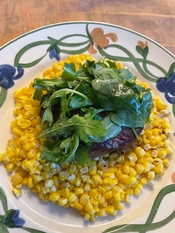Most of us have a pretty clear idea of what we consider the perfect steak. In general, Americans tend to like their steak big, and they tend to like it grilled over charcoal. I am usually happy with a smaller steak, and I like it somewhat thinner. My ideal steak is usually seasoned with nothing more than salt and pepper, and it is quickly seared in a very hot and heavy cast iron skillet. I’m okay with some of the spices, rubs and other seasonings that many people like to put on their steak but honestly, as long as the beef is of top-notch quality, I’d prefer that you save the dehydrated garlic and onion powders, along with the aggressive dried herbs and hot pepper spices for another occasion and let the steak speak for itself. If the wine you’re going to pour with that steak is special that might be even more reason to let the steak’s natural flavors shine through.  As for cooking the steak, my first choice is to quickly sear it in a smoking hot cast iron pan over a gas or (even better) induction burner. And yes, sometimes this requires dealing with a screeching smoke detector.
As for cooking the steak, my first choice is to quickly sear it in a smoking hot cast iron pan over a gas or (even better) induction burner. And yes, sometimes this requires dealing with a screeching smoke detector.
One classic way to enhance a good steak’s natural deliciousness is with butter, as the French discovered eons ago. Butter increases a steak’s natural flavor and also adds an improved overall texture and glossy finish. I tend to generally use just plain butter, but for a special occasion I’ll make a compound butter, which is the tastiest way to elevate the meat’s own flavors. For compound butter minced fresh herbs (usually parsley, garlic and sometimes thyme) are incorporated into the butter. This mixture is generally rolled up into a cigar shape, chilled, and cut in thick slices to put on top of each steak.
I’m perfectly happy with a steak grilled over charcoal but grilling isn’t a requirement for me although I know plenty of people with impeccable palates who prefer a steak licked by flames. Perhaps this is sometimes a gender issue. Years ago, when I taught French cooking classes in Sonoma, California, a man in one of the classes had a particular request: “Can we make something flambéed?” he asked. “Men like fire, you know,” he explained.
What sort of steak is best? A couple of years ago I was enamored with hanger steak. Recently I’ve shifted my allegiance to filet mignon, a.k.a., tenderloin. I know, I know—filet mignon, which may be the most expensive cut of all, is no longer considered a sophisticated choice. People say it has less flavor than other cuts but, in my opinion, as long as it hasn’t been deluged with too many rubs and other distracting seasonings, I don’t find that to be true. One of the things I like about a filet is its small, compact size, which is just about the right amount for one person, at least for this person. And since I like a thinner rather than a thick-cut steak, I sometimes cut a tenderloin in half horizontally and quick-sear the two pieces in a hot pan for just a very few minutes on both sides, which yields two steaks (or medallions) with a perfect crust and a juicy, tender, rare-to-medium interior.
For Each Serving:
One filet mignon or other steak
Salt and freshly ground black pepper
1 ½ – 2 ears corn
4 tablespoons butter (divided use)
1 small handful fresh arugula or other flavorful fresh raw greens
Season both sides of the steak with salt and pepper and let it rest for 20 minutes or so. While it is resting cut the corn kernels off the cob and place them in a small saucepan along with 2 tablespoons of the butter. Simmer for about 5 minutes or until the corn is just tender (late-season or frozen corn may require a few more minutes). Season with salt and pepper.
Meanwhile, cook the steak however you prefer, searing it in a hot skillet or on the grill. Spread a layer of the cooked corn on a plate. Place the steak in the middle of the corn and top it with the remaining butter. Top the steak with the arugula and season it lightly with salt and pepper.
Three red wines, each from a different country. Three different red grapes (Malbec, Sangiovese and Merlot). Probably none of these bottles cost much more than your steak. What they have in common is not just that they’re red, but that all three are full flavored and hearty without being explosively fruity, overly tannic or excessively alcoholic—all of which allows them to engage with the important corn component in the recipe as well as with the steak.
Bianchi, Mendoza (Argentina) Malbec “Particular” ($31, Quintessential Wines): The uncomplicated character of the red meat and the purity of the red fruits join forces in this Malbec to connect beautifully on the palate.
Castello Banfi, Rosso di Montalcino (Tuscany, Italy) ($25, Banfi): With its relatively soft texture and engaging fruitiness, this appealing Sangiovese links together the buttery corn and the steak’s delicious butter enhanced meatiness.
Rodney Strong, Sonoma County (California) Merlot ($20): The Merlot’s nicely balanced fruit and its hint of spice mirror the lightly oaked berry flavors that distinguish this cohesive and altogether tasty red wine.
